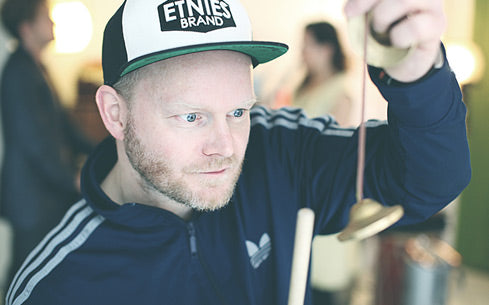Portrait: Peter Stavrum
In Portrait: Peter Stavrum
Composer, producer and music entrepreneur / Denmark

When did you develop your interest in music and how did you become a body percussionist?
I have to say, I have been drumming for as long as I can remember. It may sound cliché, but I remember well drumming on my mother's pots in the living room as a child. Music and especially the drums have always been an important part of my life, from an early age. As a teenager I played drums, blues, fusion and heavy metal. In my twenties I graduated from a Danish music conservatory. Two weeks later I went to London to apply to STOMP. I got the chance to play with them and ended up being part of the group for six years. STOMP was my first introduction to the concept of body percussion. I think it is one of the coolest ways to play music, absolutely fundamental. You clap and stomp and create a sound with your body - without an instrument standing between you and the music. You are in direct connection with the rhythmic element, with you. Body percussion is a type of dance where you add the music yourself. I quickly got used to the technique and developed a real passion for becoming more precise and faster and creating my own sound.
Is the training hard, harder than learning a “real” instrument?
Body percussion is percussion where you can immediately create your own beat by stomping and clapping. Once you have created a rhythmic foundation, the instrument is there: in you and on you. You don't need sticks, drums or a certain position, you just start clapping. From this point of view, I would say that it is easier to create new beats than, for example, composing a piece on the violin. Body percussion is a physical way of creating rhythm, it is like dancing. Therefore, it can be complicated to coordinate the hands and feet correctly and at the same time. After all, it should sound good and fit together rhythmically and musically. This interaction is a little difficult at first and it also takes some practice.
How did you get to know the Sansula?
My friend Rune, with whom I play in the group Body Rhythm Factory, brought a Sansula from Berlin. When he showed it to me, I was so amazed and impressed by the sound and that special "wah wah" sound that I immediately bought one for myself.
Your ideas and your music are unique and characterized by humor – how do you develop your concepts?
I always try to combine a few elements when I develop a new piece for my groups or projects. The most important thing is that the music is there. I focus primarily on the music groove and on making it sound good (to my ears). Then, depending on the project, I think about how I could visualize the whole thing in an interesting way. I often add a humorous touch, of course it depends on the project. For example, when I play the sansula, I play a percussion groove to the melody of the sansula or kalimba at the same time. It's quite tricky and requires full concentration. For the audience, it certainly looks quite interesting, like a juggler who faces the risk that everything could suddenly fall down. The humor in it is an extension of my personality. I can't help but just have to fool around on stage. It's a part of me and has always been that way. I also think it's very important to show personality on stage and to be a normal person.
How do you use the Sansula and what possibilities arise from it? Does it affect your audience?
The Sansula is a really versatile instrument. Of course there is this beautiful "wow" sound resonance. This is particularly suitable for ballads with a reverb (acoustic or digital). You can try out lots of things, for example reverb, delays and much more. I just can't resist and am always trying out new effects with the Sansula. Of course my playing is often very percussion-oriented, so I use the Sansula like a kind of rhythm guitar, very staccato, like a funk guitar riff. But I also like to play big chords on the piano and then use the kalimba to match the chords. It's a lot of fun for a percussionist when he can suddenly play notes, chords and melodies, after all that rarely happens. I like to mix the kalimba with other instruments. After concerts, people often come up to me and ask about the Sansula. Most of them have never heard of it.
Could the Sansula be considered a serious instrument?
Hello?! Of course!!
Your HOKEMA favorite?
Both the Renaissance and the Sansula Deluxe are fantastic. Both have a beautiful sound. The Deluxe impresses with its aesthetic appearance and beautiful, warm tone. The Renaissance convinces me because of its sound, the Remo head and its reasonable price.
Biographical information on the career
Peter Stavrum is a passionate drummer, percussionist and graduate of the Royal Music Academy Silkeborg. Just two weeks after graduating, Peter got a role in the international percussion show STOMP, where he performed and toured extensively for the next six years. After life "on the road" and six years abroad, Peter was drawn back home and returned to Copenhagen. Once back there, he stayed true to music and co-founded the group Body Rhythm Factory in 2008. The band played over 500 concerts and won the "Young Music Award" for the best performance in the world for children and young people in 2013. Peter developed an interest in body percussion during his time at STOMP. Peter has performed all over Europe and also taught body percussion. The band Funky Currywurst Brothers is also one of his charming, witty and incredibly talented music projects.
Interview: Annalena Horl
